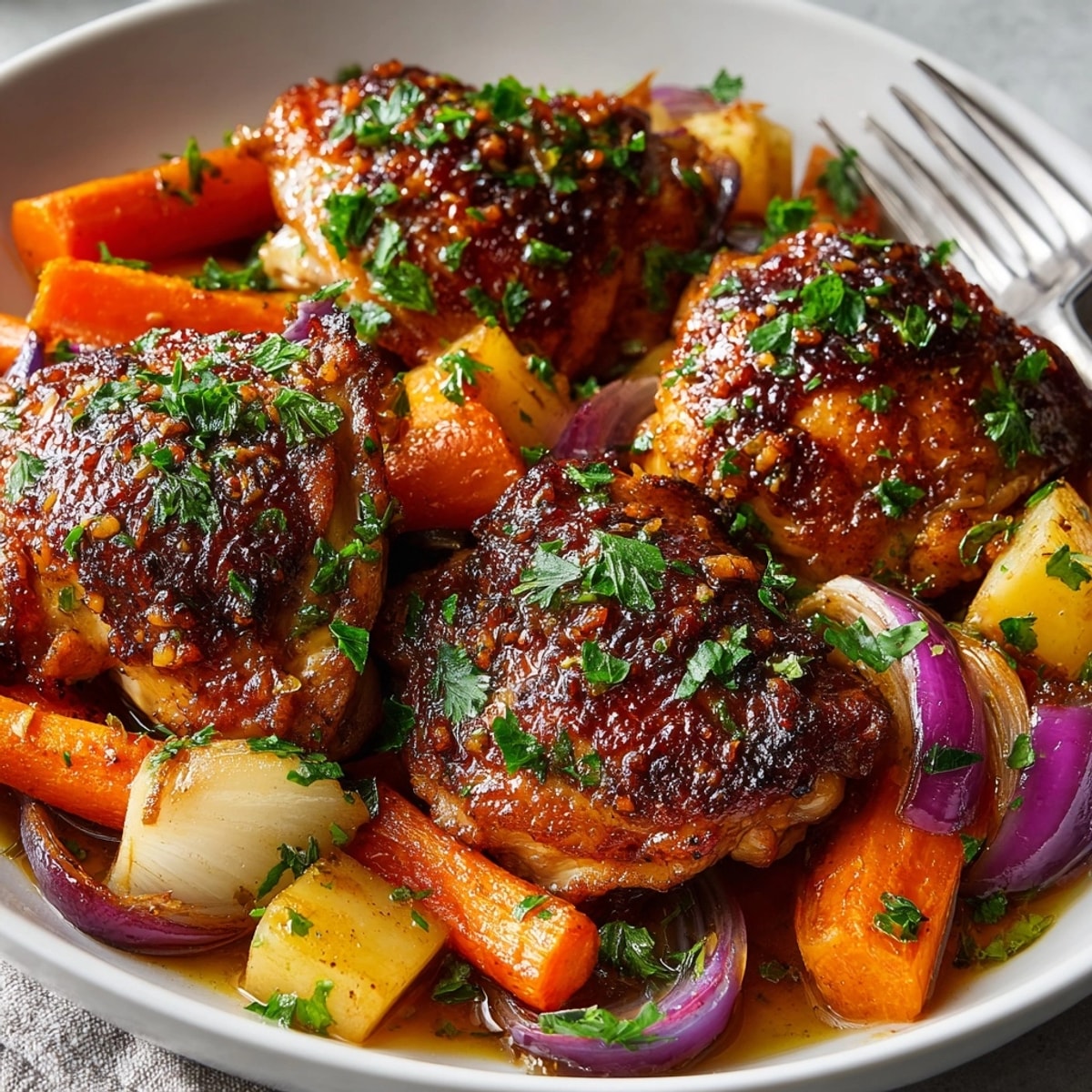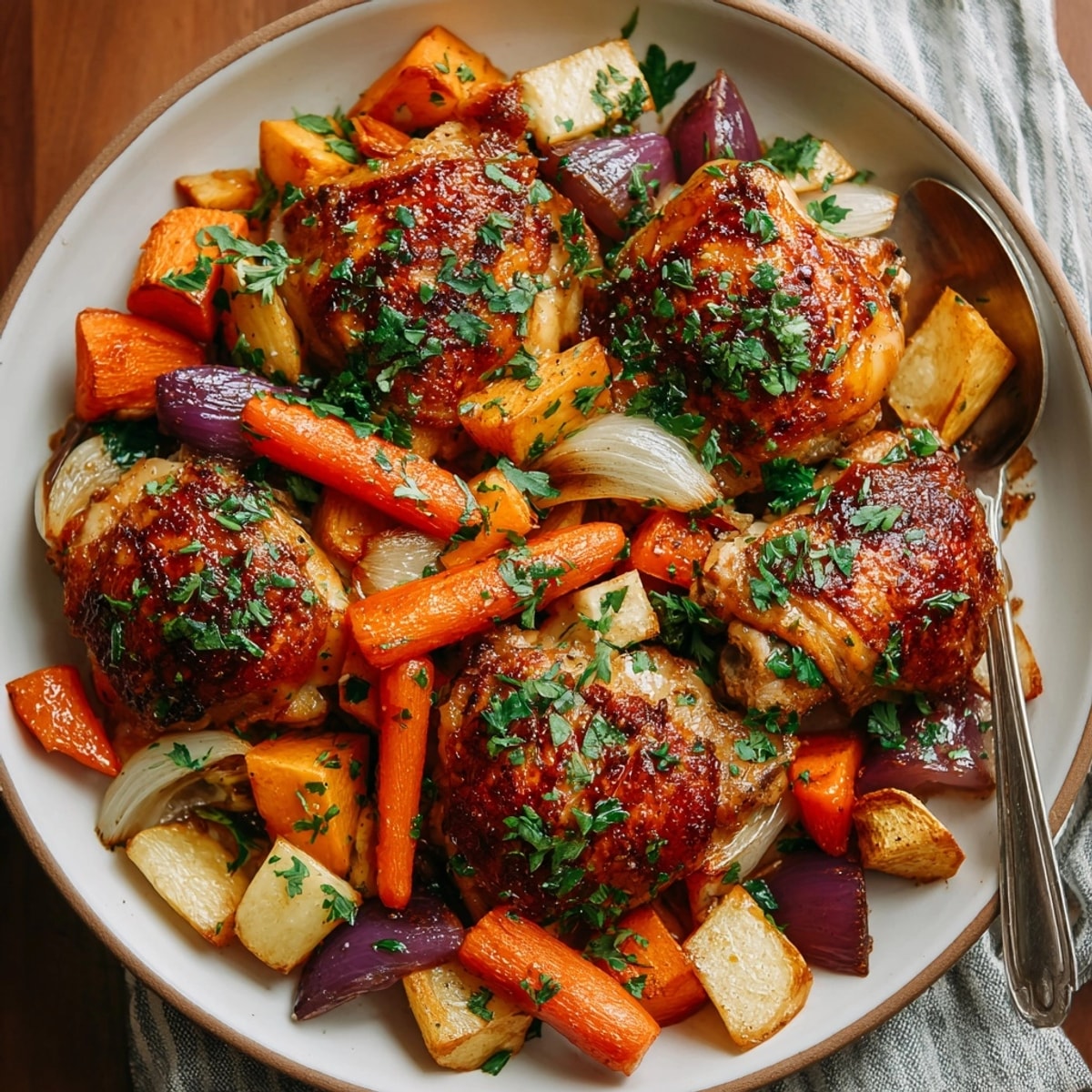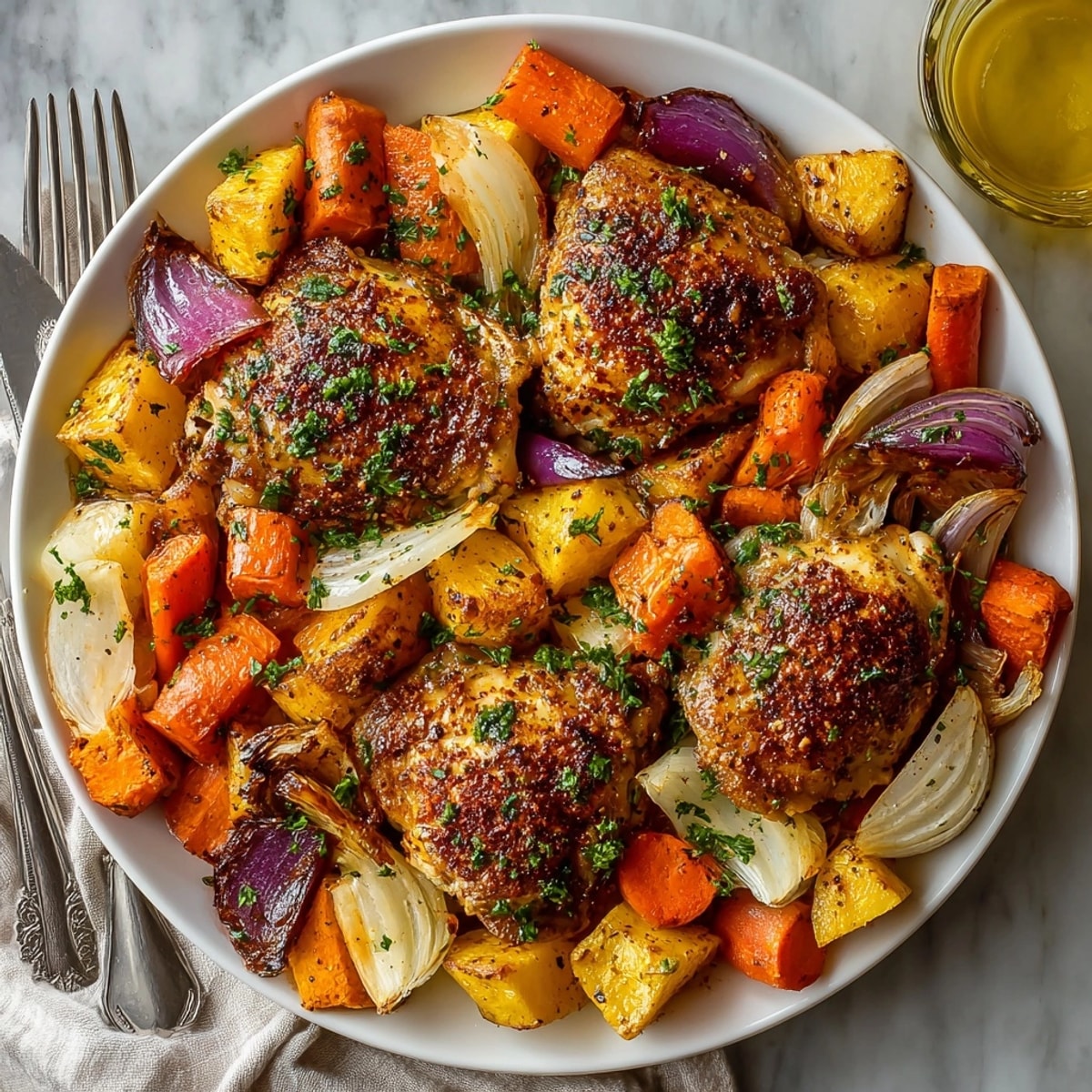 Pin
Pin This one-pan honey garlic chicken with fall root vegetables has become my ultimate lifesaver for busy weeknights when I crave something hearty but lack the energy for elaborate cooking. The magical combination of sweet honey, umami-rich soy sauce, and aromatic garlic creates a glaze that transforms ordinary chicken and vegetables into a restaurant-worthy meal.
I first created this recipe when hosting an impromptu dinner party during autumn. I needed something impressive yet simple, and this dish exceeded all expectations. The way the chicken skin caramelizes while the vegetables roast underneath in all those flavorful drippings still makes my mouth water just thinking about it.
Ingredients
- Bone-in, skin-on chicken thighs: provide rich flavor and stay incredibly juicy during roasting
- Honey: creates that beautiful caramelization and balances the savory elements
- Soy sauce: adds depth and umami notes that make the dish irresistible
- Fresh garlic: offers aromatic punch that mellows beautifully as it roasts
- Dijon mustard: brings subtle tanginess and helps emulsify the glaze
- Apple cider vinegar: brightens all the flavors with necessary acidity
- Carrots, parsnips, and sweet potatoes: create a colorful medley of fall vegetables
- Red onion wedges: become deliciously sweet and jammy when roasted
- Dried thyme and smoked paprika: infuse everything with warming, aromatic notes
- Fresh parsley: adds a pop of color and freshness to finish the dish
Instructions
- Prepare the Glaze:
- Whisk together honey, soy sauce, minced garlic, Dijon mustard, and apple cider vinegar in a small bowl until completely smooth. The mixture should have a consistency like thin syrup. Let it sit while you prepare the other components to allow the flavors to meld together beautifully.
- Season the Vegetables:
- Toss your prepped carrots, parsnips, sweet potato, and red onion in a large bowl with olive oil until every piece is lightly coated. Sprinkle with dried thyme, smoked paprika, salt, and pepper, making sure to distribute the seasonings evenly. The oil helps the spices adhere to the vegetables and promotes caramelization.
- Arrange the Baking Sheet:
- Spread the seasoned vegetables in an even layer across your baking sheet. Avoid overcrowding which would cause steaming rather than roasting. Creating a single layer ensures each vegetable gets direct heat contact for maximum caramelization and flavor development.
- Prepare the Chicken:
- Pat the chicken thighs completely dry with paper towels this crucial step ensures crispy skin. Rub them thoroughly with olive oil, salt, and pepper, making sure to season both sides. Place them skin-side up on top of the vegetables, leaving a little space between each piece.
- First Roasting Phase:
- Brush the chicken skin generously with half of your honey garlic glaze, making sure to cover the entire surface. The natural sugars will caramelize beautifully during roasting. Place the pan in your preheated oven and let it roast undisturbed for 25 minutes.
- Mid-Roast Refresh:
- Remove the pan from the oven and brush the chicken with remaining glaze, applying it thickly for maximum flavor. Gently toss the vegetables with a spatula to ensure even cooking and to coat them with the flavorful drippings from the chicken and glaze.
- Final Roasting:
- Return the pan to the oven for another 15 minutes. During this final roasting phase, the chicken will reach perfect doneness while the vegetables become tender and deeply caramelized. The glaze will transform into a sticky, irresistible coating.
- Optional Broil:
- For extra crispy, golden-brown chicken skin, switch your oven to broil for the final 2-3 minutes. Watch carefully to prevent burning as the honey in the glaze can darken quickly under the intense heat of the broiler.
- Rest and Serve:
- Allow everything to rest for 5 minutes after removing from the oven. This crucial step allows the juices to redistribute within the chicken for maximum tenderness. Sprinkle with fresh parsley just before bringing the entire pan to the table for a beautiful presentation.
 Pin
Pin 
The smoked paprika in this recipe is what truly elevates it from good to extraordinary. I discovered this ingredient years ago during a cooking class in Spain, and it has been a staple in my pantry ever since. The subtle smokiness it imparts to the vegetables creates an incredible depth that makes people wonder what your secret ingredient might be. My family now associates this particular aroma with cozy autumn gatherings.
Make-Ahead Options
This dish is perfect for meal prep enthusiasts. You can prepare all components up to 24 hours in advance and refrigerate them separately. Season the vegetables and place them in an airtight container. Prepare the chicken and store it separately. Mix the glaze and keep it in a small jar. When ready to cook, simply assemble everything on your baking sheet and proceed with roasting. This preparation method actually allows the chicken to marinate slightly, enhancing its flavor even further.
Seasonal Variations
Spring Version: Replace root vegetables with asparagus, baby potatoes, and leeks. Add fresh herbs like tarragon or dill instead of thyme. Consider adding lemon zest to brighten the flavor profile.
Summer Adaptation: Substitute zucchini, bell peppers, and cherry tomatoes for the root vegetables. Reduce cooking time by about 10 minutes as summer vegetables cook faster. Add fresh basil at the end instead of parsley for a seasonal touch.
Winter Comfort: Include more hearty root vegetables like rutabaga and turnips. Add fresh rosemary sprigs scattered throughout for a wintery aroma. Consider adding cranberries during the last 10 minutes of cooking.
Serving Suggestions
While this dish is certainly complete on its own, I love serving it with a few complementary sides to round out the meal. A simple green salad dressed with lemon vinaigrette provides a refreshing contrast to the rich, caramelized flavors. For heartier appetites, consider serving with crusty artisan bread for sopping up the incredible pan juices or a side of fluffy quinoa to absorb all the delicious sauce. For special occasions, I often start with a butternut squash soup and finish with a rustic apple crisp to create a complete fall-themed dinner.
Troubleshooting Tips
If your vegetables are cooking faster than the chicken, simply tent the pan loosely with foil to prevent them from burning while allowing the chicken to finish cooking. Conversely, if your chicken is done but vegetables need more time, remove the chicken to a plate, cover it with foil, and continue roasting the vegetables until tender. Always choose a pan large enough to avoid overcrowding, as this is the most common reason for unevenly cooked components.
 Pin
Pin This one-pan wonder has saved countless weeknight dinners at my house, and I'm confident it will become a staple in your recipe collection too. The combination of minimal effort and maximum flavor makes it perfect for both everyday family meals and special occasions. Remember to embrace the versatility of this recipe—it's a framework that invites your own creative touches and adaptations based on what's in season or available in your pantry.
Recipe Questions & Answers
- → Can I use boneless chicken instead of bone-in thighs?
Yes, boneless chicken thighs or breasts work well, but reduce cooking time by about 10 minutes and check for doneness earlier. Bone-in pieces typically yield juicier results and more flavor.
- → How do I know when the chicken is fully cooked?
Chicken is done when it reaches an internal temperature of 165°F (74°C) measured with a meat thermometer. The juices should run clear, not pink, when pierced.
- → Can I prep this dish ahead of time?
Yes! Chop all vegetables and make the glaze up to 24 hours ahead. Store separately in the refrigerator. You can also arrange everything on the baking sheet a few hours before cooking, covered in the refrigerator.
- → What other vegetables work well in this dish?
Butternut squash, turnips, rutabaga, Brussels sprouts, and beets all work beautifully. Adjust cooking times for softer vegetables by adding them later or cutting firmer vegetables into smaller pieces.
- → How can I make this dish without soy sauce?
Substitute coconut aminos for soy sauce for a soy-free version with similar umami flavor. You may need slightly less honey as coconut aminos are naturally sweeter than soy sauce.
- → What can I serve with this to complete the meal?
This dish is a complete meal on its own, but pairs beautifully with simple sides like quinoa, wild rice, crusty bread, or a light green salad to balance the richness.